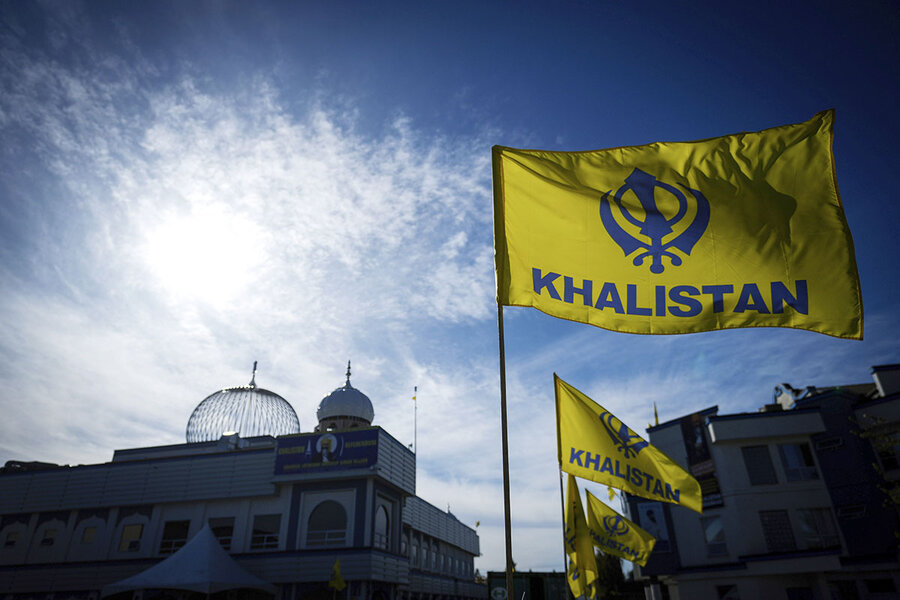Why this Sikh activist’s killing has divided India and Canada
| New Delhi
Relations between India and Canada have turned stormy after Canadian Prime Minister Justin Trudeau this week accused India of assassinating Hardeep Singh Nijjar, a Canadian citizen who actively advocated for a separate Sikh homeland in the north Indian state of Punjab.
Mr. Nijjar, who migrated from India in 1997, was shot dead outside a temple in British Columbia in June. The Indian government had declared Mr. Nijjar a terrorist in 2020, accusing him of leading the banned militant group Khalistan Tiger Force.
Authorities in India have denied Mr. Trudeau’s allegations, calling them “absurd,” and warned India’s nationals of “growing anti-India activities and politically condoned hate crimes” in Canada. Both countries have expelled senior diplomats in response to the allegation, and issued travel advisories for their citizens in a tit-for-tat move. India has also suspended visa services for Canadian citizens.
Meanwhile, the escalating tensions have brought renewed attention to Sikhs’ demand for their own state, known as Khalistan.
What is the Khalistan movement?
The Sikh community’s call for an independent ethno-religious state dates back to the tail end of British colonial rule, though the Khalistan movement began to formally take shape in the late 1970s. Across Punjab, armed insurgents launched attacks on Indian police and army soldiers, and were effectively running a parallel government in the region.
The insurgency reached a violent zenith in 1984, when the Indian army stormed the Sikhs’ holiest shrine, the Golden Temple, and killed movement leader Jarnail Singh Bhindranwale, who had fortified the temple and made it his headquarters. While the Indian government puts Operation Blue Star’s death toll at about 400, Sikh groups have argued that thousands were killed, including pilgrims.
Three months later, in retribution, India’s then-prime minister, Indira Gandhi, was assassinated by her two Sikh bodyguards, triggering riots in Delhi and other parts of the country that left thousands more dead.
Jagtar Singh, a Punjab-based journalist who has written two books on the Khalistan movement, says the killing of Mr. Bhindranwale made him an icon of the Sikh resistance, spurring support for independence but also leading to a harsh crackdown by Indian authorities.
In the chaotic years that followed, thousands of Sikhs – those affiliated with the Khalistan movement and those who weren’t – moved abroad to places such as the United Kingdom and Canada, which today is home to the largest Sikh population outside India. Some, like Mr. Nijjar, brought the Khalistani ideology with them. He sought refuge in Canada in 1997, and after working as a plumber for some time, he became a vocal activist.
Back in India, the aggressive counterinsurgency, as well as movement infighting, led most major militant factions to collapse by the mid-1990s, but the movement never actually died, says Mr. Singh.
Is the Khalistan movement still active today?
While things aren’t always peaceful in Punjab, priorities on the ground have largely shifted. Amandeep Sandhu, a Punjabi writer and journalist who has been closely following the movement, says people “have moved away from the demand of the Khalistan movement” and now want better governance and jobs.
Yet experts note that the rise of Hindu nationalism, especially in India’s ruling Bharatiya Janata Party, has helped reinvigorate interest in Khalistan as a political idea, both domestically and abroad.
“The [original Khalistan] movement was mainly an armed struggle, which is not there right now,” says Mr. Singh. “There are people who continue to raise the issue at the political levels, including in the Parliament of India. The way it is happening now – affecting the national political discourse – it certainly has gained momentum.”
However, separatist violence still occurs, and India sees Khalistan activism – especially anything that could be linked to the Khalistan Tiger Force or other present-day militant groups – as a serious national security threat. Its quest to prevent future insurgencies often bleeds overseas.
Mr. Nijjar is not the first prominent Khalistan advocate to be killed on foreign soil. Two well-known Khalistani militants were also shot this year in Lahore, Pakistan, for which Sikh activists have blamed India. And Indian consulates in London and San Francisco were vandalized by Khalistan supporters in March after India launched a massive search for separatist leader Amritpal Singh.
World Sikh Organization board member Mukhbir Singh told a news conference in Ottawa, Ontario, on Tuesday that the revelation about India’s alleged role in Mr. Nijjar’s death was no surprise. “For decades, India has targeted Sikhs in Canada with espionage, disinformation, and now murder,” he said, adding that Canada needs to take stronger measures to protect its Sikh citizens.
What lies ahead for the movement, and diplomacy?
While many credit the powerful Sikh diaspora with keeping the Khalistan issue alive, some are skeptical about the movement’s future.
“The average Sikh migrants living abroad work hard to earn money; they send some money back to the family in Punjab,” says Mr. Sandhu. “And once in a while they go to gurudwaras [Sikh temples], many of which keep talking about Khalistan, [but] they are not actively pursuing Khalistan.”
Shinder Purewal, a professor of political science at the Kwantlen Polytechnic University in Canada, who has been studying the evolution of the Sikh secessionist movement in Western liberal democracies, agrees that there’s little public sympathy for the Khalistan movement’s historically violent tactics. But that doesn’t mean the desire for autonomy has disappeared.
“In comparison with the past, the movement is smaller and weaker,” he says. “However, the social media hype and years of nurturing relations with the Liberal Party of Canada have given them a louder voice in higher echelons of power.”
Even still, many believe the current India-Canada tensions are temporary, both because of the lack of a proper road map among Khalistan supporters and due to India’s geopolitical importance for the West.
Professor Purewal says Canada’s accusation will “have an immediate impact on bilateral ties, although sane voices will prevail in the long term because the U.S. and the West see India as a strategic partner.”
But some experts do not see the Khalistan movement dying down, at least not until Delhi finds a peaceful solution to address the concerns of Sikhs in Punjab.
“You cannot kill a political movement through police methods. It has to revive at some stage,” says Mr. Singh. When it comes to the thousands of Sikhs killed during the height of the Khalistan movement, he adds, “there has to be some accountability.”






